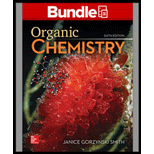
(a)
Interpretation: The products formed by the treatment of A and B with reagent
Concept introduction: The replacement or substitution of one functional group with another different functional group in any
Answer to Problem 37P
The products formed by the treatment of A and B with reagent
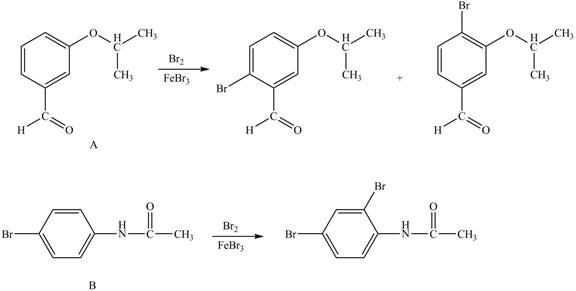
Explanation of Solution
In the given ball and stick model of A and B, black balls represent carbon atoms, white balls represent hydrogen atoms, red balls represent oxygen atoms, blue ball represents nitrogen atom and brown ball represents bromine atom. Therefore, the structure of A and B is,

Figure 1
Reagent
Hence, the products obtained from the treatment of A and B with reagent
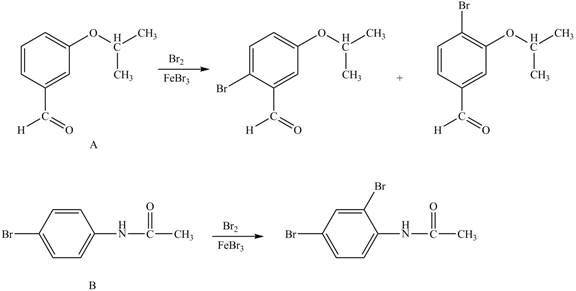
Figure 2
The products formed by the treatment of A and B with reagent
(b)
Interpretation: The products formed by the treatment of A and B with reagent
Concept introduction: The replacement or substitution of one functional group with another different functional group in any chemical reaction is termed as substitution reaction. The electron deficient chemical species that contains positive charge are known as electrophile. In electrophilic aromatic substitution reaction, electrophile takes the position of hydrogen atom by attacking the electron rich carbon atom of benzene.
Answer to Problem 37P
The products formed by the treatment of A and B with reagent

Explanation of Solution
The structure of A and B is shown in Figure 1.
Reagent
Hence, the products obtained from the treatment of A and B with reagent

Figure 3
The products formed by the treatment of A and B with reagent
(c)
Interpretation: The products formed by the treatment of A and B with reagent
Concept introduction: The replacement or substitution of one functional group with another different functional group in any chemical reaction is termed as substitution reaction. The electron deficient chemical species that contains positive charge are known as electrophile. In electrophilic aromatic substitution reaction, electrophile takes the position of hydrogen atom by attacking the electron rich carbon atom of benzene.
Answer to Problem 37P
The products formed by the treatment of A and B with reagent
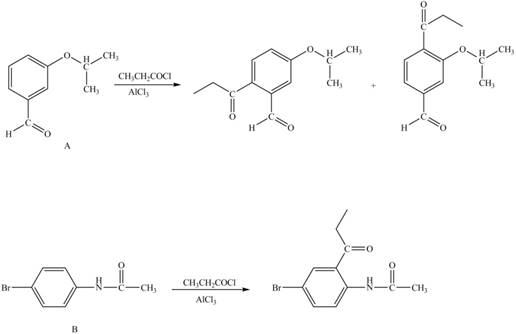
Explanation of Solution
The structure of A and B is shown in Figure 1.
Reagent
Hence, the products obtained from the treatment of A and B with reagent
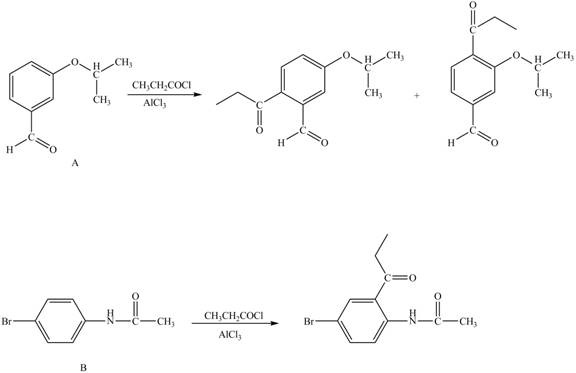
Figure 4
The products formed by the treatment of A and B with reagent
Want to see more full solutions like this?
Chapter 16 Solutions
Package: Loose Leaf For Organic Chemistry With Connect Access Card (1 Semester)
- When the conjugate acid of aniline, C6H5NH3+, reacts with the acetate ion, the following reaction takes place: C6H5NH3+(aq)+CH3COO(aq)C6H5NH2(aq)+CH3COOH(aq) If Kafor C6H5NH3+ is 1.35105 and Kafor CH3COOH is 1.86105 , what is K for the reaction?arrow_forwardDraw a resonance structure of the acetonitrile anion, -: CH2CN, and account for the acidity of nitriles.arrow_forwardWhat product is formed when each compound is treated with K 2Cr 2O 7? With some compounds, no reaction occurs.arrow_forward
- Draw the products formed when phenol (C6H5OH) is treated with following set of reagents. [1] CH3CH2Cl, AlCl3; [2] Br2, hνarrow_forwardDraw the products a. Pentyl butanoate reacts with water and NaOH b. Acetic anhydride reacts with ethanol c. 3-hexanone reacts with two equivalents of isopropyl alcohol d. Hexanal reacts with NaBH4 and CH3OHarrow_forwardWhat product is formed when D-Gulose is treated with a. CH3I, Ag2O b. The product in (a), then H3O+ c. The product in (b), then C6H5CH2Cl, Ag2Oarrow_forward
- What product is formed when each compound is treated with either Ag2O, NH4OH or Na2Cr2O7, H2SO4, H2O?arrow_forwardDraw the structure of the predominant form of CF3CH2OH (pK a = 12.4) at pH = 6.arrow_forwardDraw the product formed when (CH3)2CHOH is treated with each reagent. a.SOCl2, pyridine b. TsCl, pyridine c.H2SO4 d.HBr e.PBr3, then NaCN f.POCl3, pyridinearrow_forward
- Draw the product formed when (CH3)2CHOH is treated with each reagent. a. SOCl2, pyridine b. TsCl, pyridine c. H2SO4 d. HBr e. PBr3, then NaCN f. POCl3, pyridinearrow_forwarda) Draw two different enol tautomers of 2-methylcyclohexanone. (b) Draw two constitutional isomers that are not tautomers, but contain a C = C and an OH group.arrow_forwardWhat products are formed when benzoic acid (C 6H 5COOH) is treated with each base: (a) NaOH; (b) Na 2CO 3; (c) NaHCO 3?arrow_forward
 Chemistry: Principles and ReactionsChemistryISBN:9781305079373Author:William L. Masterton, Cecile N. HurleyPublisher:Cengage Learning
Chemistry: Principles and ReactionsChemistryISBN:9781305079373Author:William L. Masterton, Cecile N. HurleyPublisher:Cengage Learning

